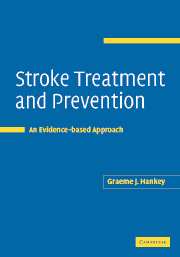Book contents
- Frontmatter
- Contents
- Preface
- 1 The size of the problem of stroke
- 2 Understanding evidence
- 3 Organised acute stroke care
- 4 General supportive acute stroke care
- 5 Reperfusion of ischaemic brain by thrombolysis
- 6 Augmentation of cerebral blood flow: fibrinogen-depleting agents, haemodilution and pentoxifylline
- 7 Neuroprotection
- 8 Treatment of brain oedema
- 9 Anticoagulation
- 10 Antiplatelet therapy
- 11 Carotid artery revascularisation
- 12 Lowering blood pressure
- 13 Lowering blood cholesterol concentrations
- 14 Modification of other vascular risk factors and lifestyle
- 15 Antithrombotic therapy for preventing recurrent cardiogenic embolism
- 16 Arterial dissection and arteritis
- 17 Treatment of intracerebral haemorrhage
- 18 Treatment of subarachnoid haemorrhage
- References
- Index
18 - Treatment of subarachnoid haemorrhage
Published online by Cambridge University Press: 23 December 2009
- Frontmatter
- Contents
- Preface
- 1 The size of the problem of stroke
- 2 Understanding evidence
- 3 Organised acute stroke care
- 4 General supportive acute stroke care
- 5 Reperfusion of ischaemic brain by thrombolysis
- 6 Augmentation of cerebral blood flow: fibrinogen-depleting agents, haemodilution and pentoxifylline
- 7 Neuroprotection
- 8 Treatment of brain oedema
- 9 Anticoagulation
- 10 Antiplatelet therapy
- 11 Carotid artery revascularisation
- 12 Lowering blood pressure
- 13 Lowering blood cholesterol concentrations
- 14 Modification of other vascular risk factors and lifestyle
- 15 Antithrombotic therapy for preventing recurrent cardiogenic embolism
- 16 Arterial dissection and arteritis
- 17 Treatment of intracerebral haemorrhage
- 18 Treatment of subarachnoid haemorrhage
- References
- Index
Summary
The fundamentals of managing patients with aneurysmal subarachnoid haemorrhage (SAH) is to make the diagnosis, locate the aneurysm and occlude it. And yet, as simple as that sounds, about half of the patients in the general population still die, half of the survivors remain severely disabled and many functionally independent patients have impaired quality of life (Hijdra et al., 1987a; Hop et al., 1997; Olafsson et al., 1997; Hop et al., 1998).
The opportunities to improve the outcome of patients with SAH are to minimise the early and late deaths, and the many complications of the disease such as re-bleeding, delayed cerebral ischaemia, hydrocephalus and a variety of systemic disorders.
About 15% of patients die outside hospital within hours of the onset and, of those patients who reach hospital alive, a further 10–12% die within 24 h of the first bleed (Crawford and Sarner, 1965; Ljunggren et al., 1985; Inagawa et al., 1995; Schievink et al., 1995). Re-bleeding is the cause of death in 50% of patients who die within the first day of admission to hospital (Locksley, 1966; Hijdra and van Gijn, 1982; Broderick et al., 1994). The other common cause of early death is primary dysfunction of the brainstem from massive intraventricular haemorrhage, including distension of the fourth ventricle with blood (Shimoda et al., 1999).
The 25% of patients who die within 24 h of the onset of SAH, outside or just inside hospital, are unlikely to be prevented by medical and surgical interventions in the near future.
- Type
- Chapter
- Information
- Stroke Treatment and PreventionAn Evidence-based Approach, pp. 376 - 406Publisher: Cambridge University PressPrint publication year: 2005



